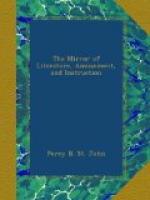The next royal blood that stained Pontefract castle was that of King Richard ii. who was here murdered or starved to death; though there is a tradition that it was merely given out that Richard had starved himself to death, and that he escaped from Pontefract to Mull, whence he shortly proceeded to the mainland of Scotland, where, for nineteen years, he was entertained in an honourable but secret captivity.[3] The matter remains in tragic darkness.[4] In the succeeding reign of Henry IV. Richard Scroope, archbishop of York, being taken prisoner, was in Pontefract castle, condemned to death. Next in the calendar of atrocities committed within these drear walls, were the murders of Anthony Woodville, Earl Rivers; Richard, Lord Grey; Sir Thomas Vaughan; and Sir Richard Hawse, in 1483; by Richard III., whom Shakspeare makes to whine forth:
O Pomfret, Pomfret! O thou bloody
prison!
Fatal and ominous to noble peers!
Within the guilty closure of thy walls,
Richard ii. here was hack’d
to death;
And for more slander to thy dismal seat,
We give to thee our guiltless blood to
drink.
We may now pass over matters of minor importance in the history of Pontefract to the time of Charles I. In the King’s contest with his Parliament, this was the last fortress that held out for the unfortunate monarch. At Christmas 1644, Sir Thomas Fairfax laid siege to the castle, and on Jan. 19, following, after an incessant cannonade of three days, a breach was made: the brave garrison would not surrender; the besiegers mined, but the besieged counter-mined, and the work of slaughter went on till the garrison were greatly reduced. At length the Parliamentarians were attacked and repulsed by a reinforcement of Royalists from Oxford, and thus ended the first siege of Pontefract. In March, 1645, the enemy again took possession of the town, and after three months cannonade, the garrison being reduced almost to a state of famine, surrendered the castle by an honourable capitulation on June 20. Sir Thomas Fairfax was appointed governor, and he thinking the royal party to be subdued, appointed a colonel as his substitute, with a garrison of 100 men. The royalists next by stratagem recovered Pontefract, of which Sir John Digby was appointed governor.
The third and final siege of this fine castle commenced in October, 1648. General Rainsborough was appointed to the command of the army, but he being previously intercepted at Doncaster, Oliver Cromwell undertook to conduct the siege. After having remained a month before the fortress, without making any impression on its massy walls, Cromwell joined the grand army under Fairfax, and General Lambert being appointed commander in chief of the forces before the castle, arrived at Pontefract on the 4th of December.
The engraving represents the castle precisely at this period. It is copied from a large print taken from a drawing found in the possession of a descendant of the Fairfax family of Denton; in one angle is the following memorandum: “Governor Morris commanded in the Castle. General Lambert commanded the Siege, being appointed thereto on the death of General Rainsborough, who was intercepted and killed at Doncaster, by a party from the Castle, as he was going to take command.”




